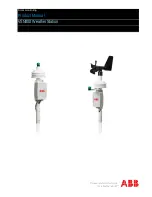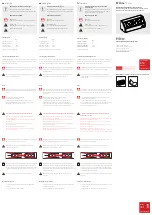
Specifications:
Model Numbers:
RS1000 - Wireless RainSensor
RFS1000 - Wireless Rain Freeze
Receiver Mounting Options:
Stainless steel screws and/or double-sided foam tape.
Sensor/Transmitter Mounting Options:
Quick-Clip
TM
rain gutter bracket, roof
eaves/fascia mounting bracket with stainless steel screws and conduit adapter for
conduit mount.
Sensor/Transmitter Range:
Up to 300' (91.4m) LOS (line-of-sight).
Sensor Type:
Industry-standard hygroscopic disc stack with adjustable rainfall sensitivity.
Transmitter Battery Type:
(2) 3V cells - CR2032 (or equivalent).
Average Battery Life:
Five years
Operating Temperature Range:
-20°F to 120°F (-29°C to 49°C)
Receiver Power Input:
22–28 VAC/VDC, 100mA (from existing controller/timer with
Class 2, UL-approved transformer).
Relay Contacts Output:
Normally Open (NO) and Normally Closed (NC) 3A at 24 VAC.
Receiver Controls:
Sensor Status Indicator, Signal Indicator, Smart Bypass Switch,
Power Indicator with low battery/poor communication warning.
Electromagnetic Compatibility
Domestic:
This device complies with FCC rules Part 15. Operation is subject to the following two
conditions: (1) This device may not cause harmful interference and (2) this device must accept any
interference that may be received, including interference that may cause undesirable operation.
This equipment generates and uses radio frequency energy and if not installed and used properly,
that is, in strict accordance with the manufacturer's instructions, may cause interference to radio and
television reception. It has been type tested and found to comply with the limits for a FCC Class B
computing device in accordance with the specifications in Subpart J of Part 15 of FCC Rules, which
are designed to provide reasonable protection against such interference in a residential installation.
However, there is no guarantee that interference will not occur in a particular installation. If this
equipment does cause interference to radio or television reception, which can be determined by
turning the equipment off and on, the user is encouraged to try to correct the interference by one or
more of the following measures:
Reorient the receiving antenna, relocate the remote control receiver with respect to the radio/TV
antenna or plug the irrigation controller into a different outlet so that the irrigation controller and
radio/TV are on different branch circuits.
If necessary, the user should consult the dealer or an experienced radio/television technician for
additional suggestions. The user may find the following booklet prepared by the Federal
Communications Commission helpful:
"How to Identify and Resolve Radio-TV Interference Problems". This booklet is available from the
U.S. Government Printing Office, Washington, DC 20402. Stock No. 004-000-00345-4.
International:
This is a CISPR 22 Class B product.
FCC ID: OF7WRS1
IC: 3949104244A
© 2005 Irritrol
Form Number 373-0287 Rev. B
For Technical Assistance:
951-785-3623 or 800-634-8873
www.irritrol.com






























